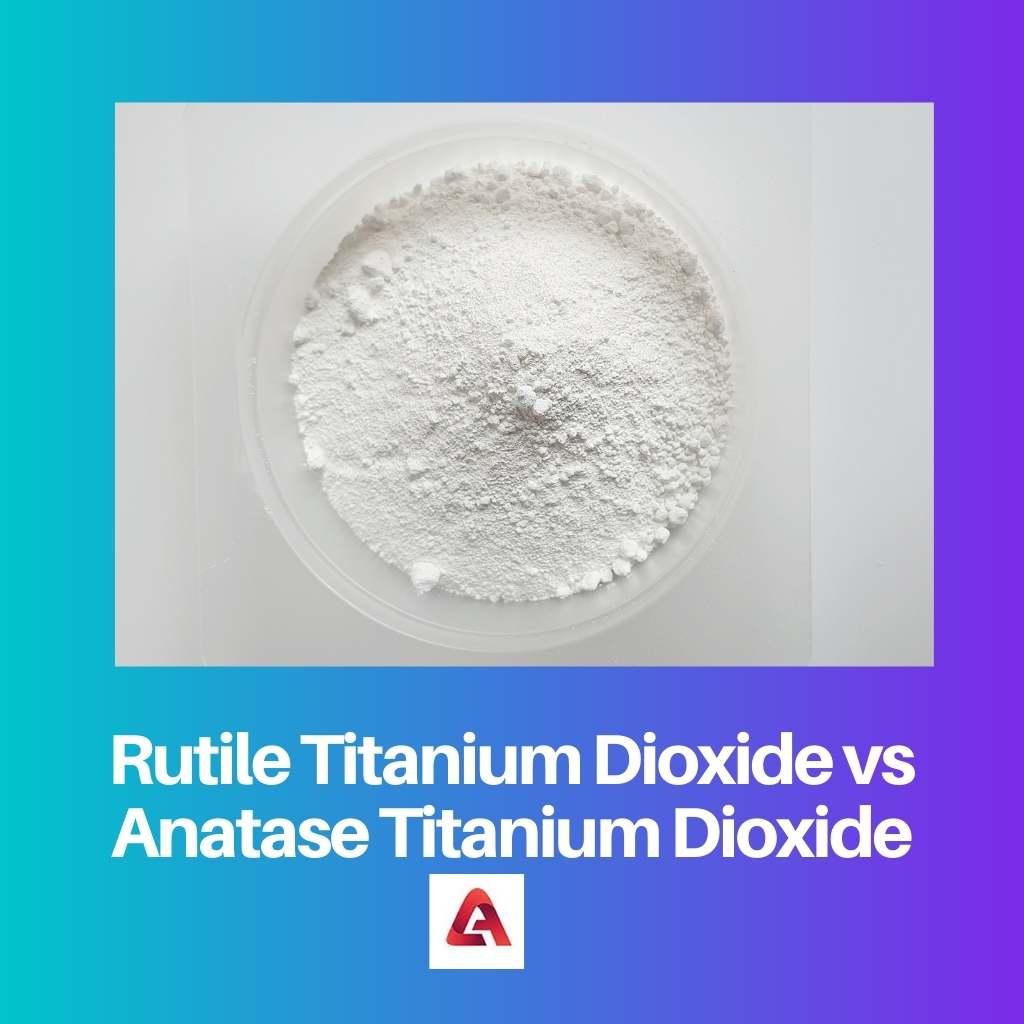Rutile titanium dioxide and anatase titanium dioxide are two different sub-class under titanium dioxide. The subclass is get confused by its terms.
Rutile and Anatase are two different forms of minerals having more amount of titanium dioxide. Titanium dioxide is mineral-rich and is present majorly in igneous rocks.
Key Takeaways
- Rutile and anatase are two crystal forms of titanium dioxide, a naturally occurring mineral used in various applications such as pigments, sunscreens, and photocatalysts.
- Rutile titanium dioxide has a denser crystal structure, higher refractive index, and better UV resistance, making it more suitable for applications like paints, coatings, and plastics.
- Anatase titanium dioxide has better photocatalytic properties and is used in applications such as air and water purification, self-cleaning surfaces, and solar cells.
Rutile Titanium Dioxide vs Anatase Titanium Dioxide
Rutile is a naturally occurring mineral that is mined for its titanium content, while anatase is produced by synthesizing titanium dioxide from other sources. Rutile has a more compact crystal structure than anatase. Rutile is also used in the production of titanium metal, unlike anatase.

An oxide mineral composed of titanium dioxide is called rutile titanium dioxide. Rutile is the most common form of titanium dioxide. At visible length, a greater refractive index is available in rutile titanium dioxide.
It shows high dispersion with birefringence in any crystal. Rutile titanium dioxide is used for optics for longer visible infrared wavelengths.
It is primarily used in the polarization of the optics. It works up to 4.5 micrometres.
A 10% iron is present in the natural rutile.
Titanium dioxide, which is in the form of a metastable mineral, is called anatase titanium dioxide. A black solid in the natural mineral form of the anatase titanium dioxide.
The pure material of the anatase titanium dioxide is white or colorless. Sharply-developed crystals are the source of anatase titanium dioxide.
It is present in a small amount in those crystals.
At all temperatures and pressures, anatase titanium dioxide is metastable.
It acts as an equilibrium polymorph when reacting with rutile titanium dioxide.
Comparison Table
| Parameters of comparison | Rutile Titanium Dioxide | Anatase Titanium Dioxide |
|---|---|---|
| Availability | Rutile titanium dioxide present in a large amount | Anatase titanium dioxide is present in a small amount |
| Ultraviolet absorption | Rutile titanium dioxide absorbs more amount of ultraviolet rays | Anatase titanium dioxide absorbs a fewer amount of ultraviolet rays |
| Hardness | Rutile titanium dioxide have greater hardness | Anatase titanium dioxide is less hardness |
| Density | Rutile titanium dioxide has a greater density | Anatase titanium dioxide has less density |
| Reflex index | The refractive index of rutile titanium dioxide is 2.52 | The refractive index of anatase titanium dioxide is 2.71 |
What is Rutile Titanium Dioxide?
An oxide mineral composed of titanium dioxide is called rutile titanium dioxide. Rutile is the most common form of titanium dioxide.
At visible length, a greater refractive index is available in rutile titanium dioxide. It shows high dispersion with birefringence in any crystal.
Rutile titanium dioxide is used for optics for longer visible infrared wavelengths. It is primarily used in the polarization of the optics.
It works up to 4.5 micrometres. A 10% iron is present in the natural rutile.
The term ‘Rutile’ is taken from the Latin word ‘rutilus’. It means deep red color. In 1803, Rutile was first discovered by Abraham Gottlob Werner.
It is present in igneous rocks and metamorphic rocks. It can accommodate high temperatures and high pressure.
In titanium dioxide, rutile is the stable polymorph by thermodynamics. During those times, rutile exhibits low energy.
The transformation of rutile titanium dioxide into rutile is irreversible.
The tetragonal unit cell is the shape of the rutile. The parameters of units are 4.584 degrees.
It has six oxygen atoms called octahedrons. The octahedron shape of the rutile makes its screw axis sequentially.
Nanorods and abnormal grain are the growth of rutile in the c-axis. Fe, Nb, and Ta are the common impurities of rutile titanium dioxide.
The rutile titanium dioxide is insoluble in acids. It has strong dispersion.
It has the capability to be fusible in alkalies.
What is Anatase Titanium Dioxide?
Titanium dioxide, which is in the form of a metastable mineral, is called anatase titanium dioxide. A black solid in the natural mineral form of the anatase titanium dioxide.
The pure material of the anatase titanium dioxide is white or colorless. Sharply-developed crystals are the source of anatase.
It is present in a small amount in those crystals. At all temperatures and pressures, the anatase is metastable.
It acts as an equilibrium polymorph when reacting with rutile titanium dioxide.
Because of its lower surface energy, anatase is used in many processes and phases. At some elevated temperatures, anatase titanium dioxide transformed into rutile.
The anatase titanium dioxide has perfect cleavages at the angle of 82°9′, parallel to the mineral’s faces. It is a common pyramid of anatase titanium dioxide.
The word anatase is from the Greek word anatasis. The word anatasis means extension. It was named by Rene Just Hauy in 1801.
In nature, anatase titanium dioxide has negative optics. The strong adamantine or metallic adamantine are the features of anatase titanium dioxide, which are different from rutile.
Under ultraviolet radiation, titanium dioxide shows antifogging characteristics and self-cleaning properties. Tetragonal is the crystal system, and Ditetragonal dipyramidal is the anatase titanium dioxide crystal class.
Main Differences Between Rutile Titanium Dioxide and Anatase Titanium Dioxide
- 2.52 is the refractive index of rutile, whereas 2.71 is the refractive index of anatase.
- The density is high in rutile, whereas the density is low in anatase.
- The hardness character is high in rutile but low in anatase.
- Rutile absorbs more amount of ultraviolet rays, but Anatase absorbs a fewer amount of ultraviolet rays.
- Rutile is present in large amounts, but Anatase is present in small amounts.



